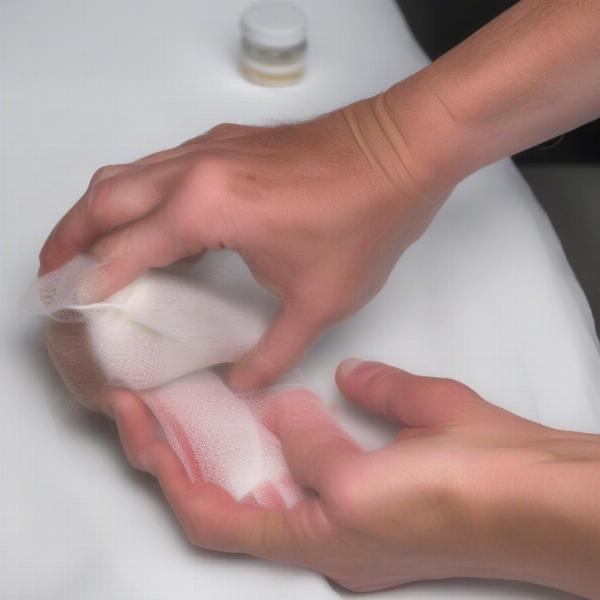A cut on your dog’s paw can be a worrying experience for both you and your furry friend. Knowing how to treat a dog cut on the paw is essential for every dog owner. Whether it’s a minor scrape or a deeper laceration, prompt and proper care can prevent infection and help your dog heal quickly. This article will guide you through the steps to effectively treat a cut on your dog’s paw and when to seek veterinary care.
Identifying the Severity of the Cut
Before starting any treatment, assess the cut. A superficial scrape might only require cleaning, while a deeper cut, one that bleeds profusely, exposes bone or tendon, or involves a puncture wound, needs immediate veterinary attention. Signs of infection, such as swelling, redness, pus, or a foul odor, also warrant a trip to the vet.
Cleaning the Wound
For minor cuts, start by gently cleaning the area. Use lukewarm water and a mild antiseptic solution, like diluted povidone-iodine or chlorhexidine. Avoid using hydrogen peroxide, as it can damage healthy tissue and impede healing. Thoroughly rinse the wound to remove any debris or dirt. how to treat a dog cut on the paw offers more detailed information on cleaning and treating paw injuries.
Stopping the Bleeding
If the cut is bleeding, apply direct pressure using a clean gauze pad or cloth. Hold the pressure for several minutes until the bleeding subsides. For small cuts, the bleeding usually stops relatively quickly. However, if the bleeding is heavy or doesn’t stop after 10-15 minutes of pressure, seek immediate veterinary care.
{width=600 height=600}
Bandaging the Paw
Once the bleeding has stopped and the wound is clean, you can bandage the paw. Use a non-stick sterile dressing pad and secure it with a self-adhering bandage. Ensure the bandage is snug but not too tight, as it could restrict blood flow. Change the bandage daily and keep the wound clean and dry. You may need to use an Elizabethan collar (cone) to prevent your dog from licking or chewing the bandage. cut dog paw pad provides more specific advice on bandaging paw pad injuries.
Pain Relief and Medication
If your dog appears to be in pain, consult your vet about appropriate pain relief medication. Never give your dog human pain relievers, as many are toxic to dogs. Your veterinarian may prescribe antibiotics to prevent or treat infection, especially for deeper cuts or puncture wounds.
Monitoring the Healing Process
Keep a close eye on the wound for any signs of infection. If you notice increased swelling, redness, pus, a foul odor, or if your dog seems to be in more pain, contact your vet immediately.
When to Seek Veterinary Care
While minor cuts can often be treated at home, it’s crucial to know when to seek professional help. Deep cuts, puncture wounds, heavy bleeding, and signs of infection require immediate veterinary attention. cut in dog paw explains in detail the different types of paw injuries and when veterinary care is necessary.
Conclusion
Knowing how to treat a cut on dog paw is vital for every dog owner. By following these steps and knowing when to seek professional help, you can ensure your furry friend receives the best possible care and recovers quickly.
FAQ
- How can I prevent my dog from licking his paw? Use an Elizabethan collar (cone) to prevent your dog from accessing the wound.
- Can I use Neosporin on my dog’s paw? While small amounts of plain Neosporin are generally considered safe, it’s best to consult your veterinarian before applying any medication.
- How long does it take for a cut on a dog’s paw to heal? Healing time varies depending on the severity of the cut. Minor cuts may heal within a week or two, while deeper cuts can take several weeks or longer.
- What are the signs of infection in a dog’s paw? Signs of infection include increased swelling, redness, pus, a foul odor, and increased pain.
- How can I protect my dog’s paws from cuts? Keep your dog’s nails trimmed, avoid walking on rough surfaces, and check their paws regularly for any injuries.
- When should I take my dog to the vet for a cut paw? Seek veterinary care for deep cuts, puncture wounds, heavy bleeding, and any signs of infection.
- Can I use hydrogen peroxide to clean my dog’s paw? No, avoid using hydrogen peroxide, as it can damage healthy tissue.
Related Articles
About ILM Dog
ILM Dog (ILM Dog) is your trusted global resource for expert dog care advice. We provide practical, up-to-date information on dog breeds, health, training, nutrition, grooming, and much more. Whether you’re a new dog owner or a seasoned expert, ILM Dog offers valuable insights to help you provide the best possible care for your canine companion. For personalized advice or questions about your dog’s specific needs, contact our expert team at [email protected] or call us at +44 20-3965-8624.
